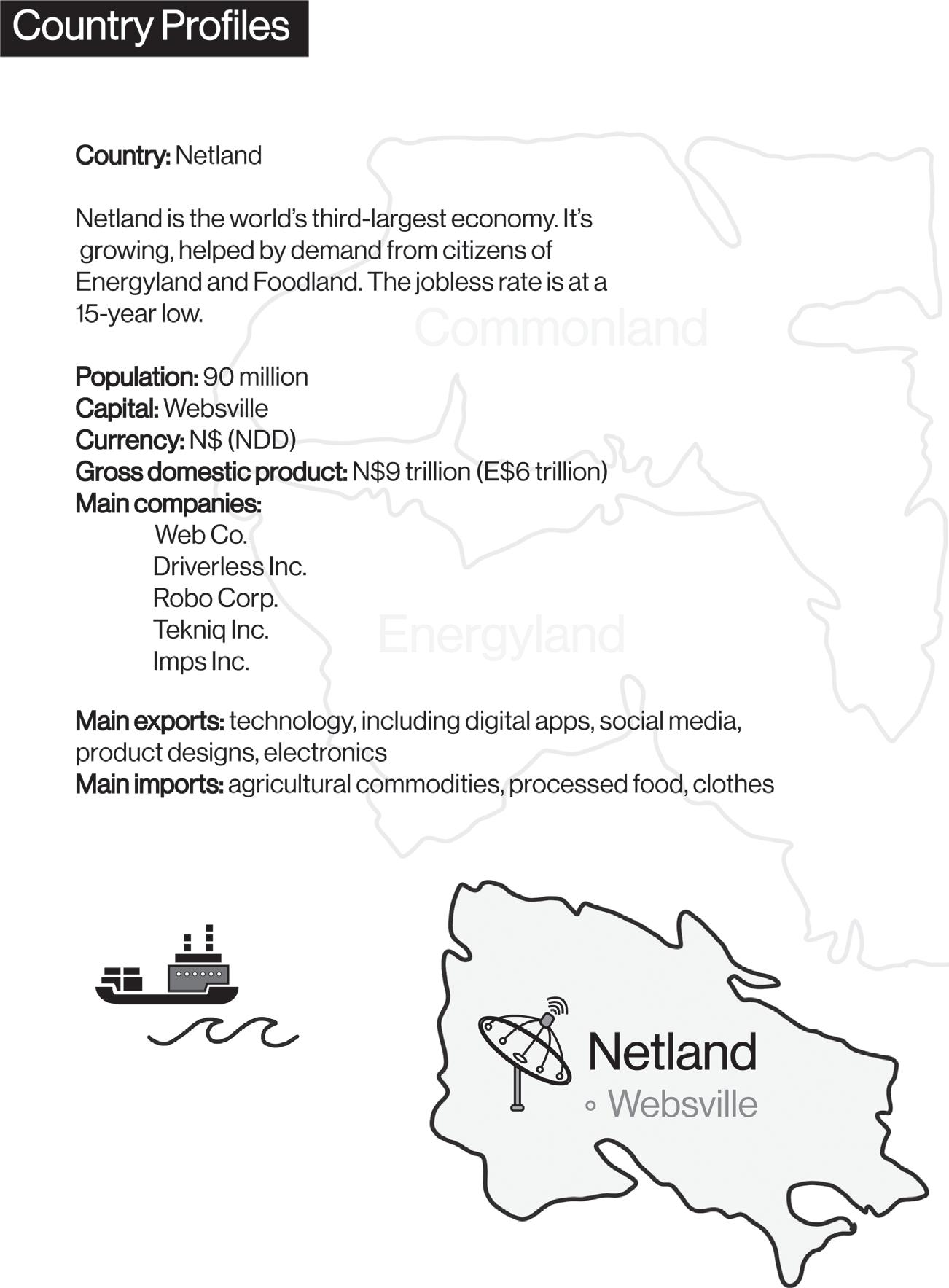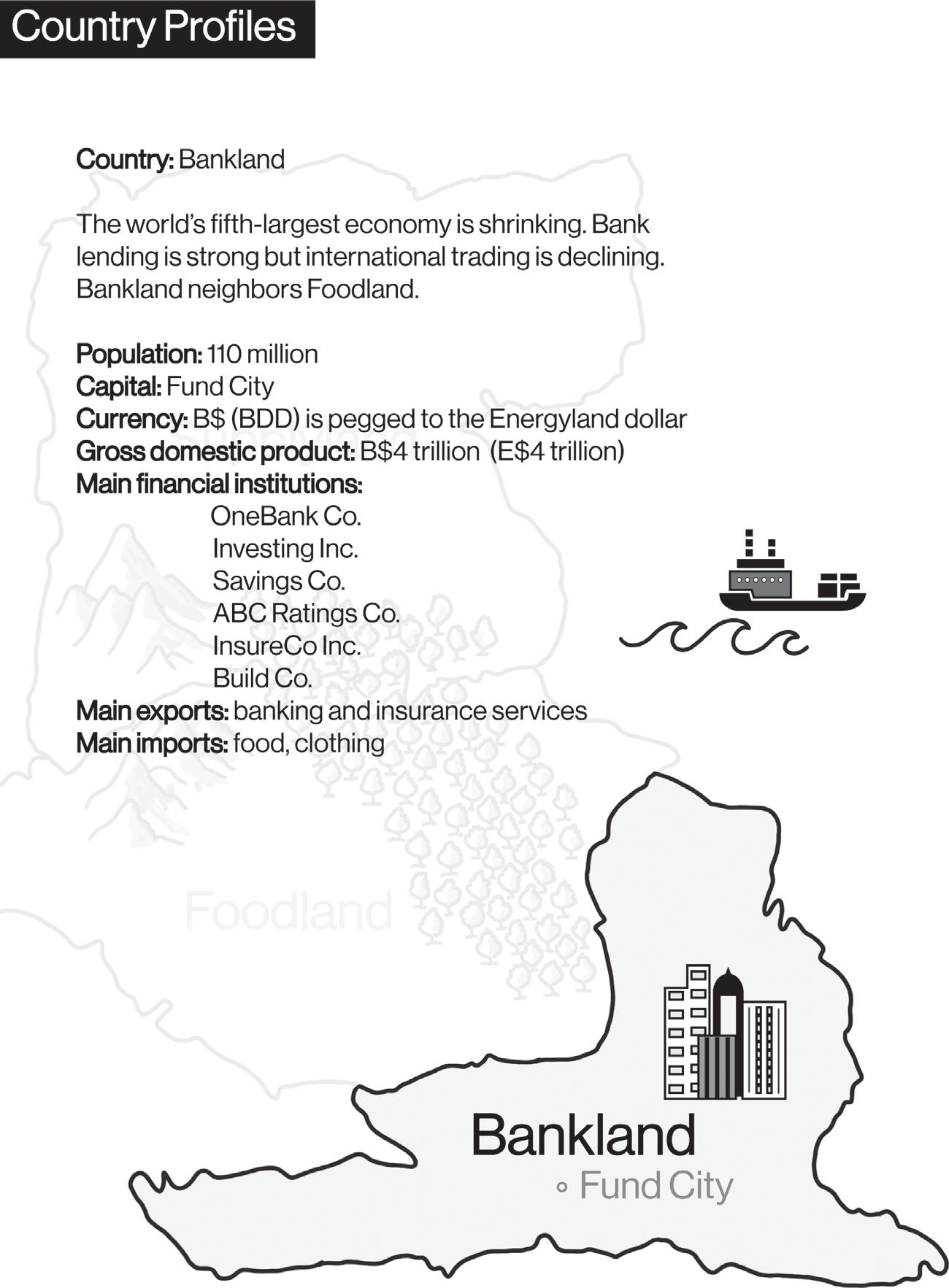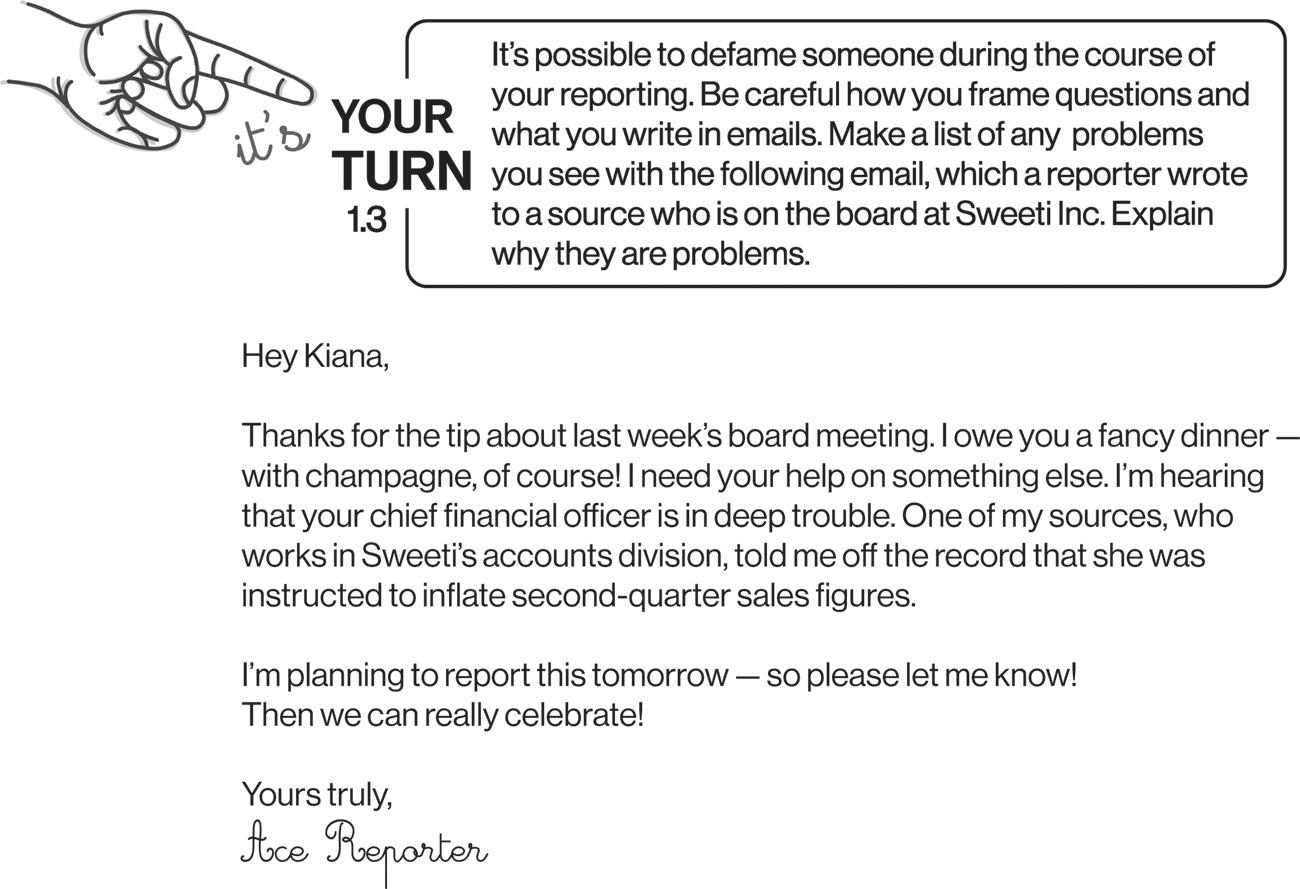










“Follow the money”—three words popularized by the 1976 movie All the President’s Men —is more than just a catch phrase. So, too, is the slogan “(It’s) the economy, stupid,” coined during Bill Clinton’s election campaign in 1992. For business journalists, these expressions are a way of life, and this book is designed to show how they think, report and communicate in different formats and on a multitude of platforms. You will learn the following in this chapter:
• How to use this book
• What makes a business story
• How to combine words and data
• Best practices and ethics
Welcome to Businessworld
The real-life world of business is extremely fast paced. Companies’ fortunes rise and fall. Economies expand and contract. Major events such as wars, elections, epidemics and natural disasters frequently upend financial
markets, sometimes in a matter of seconds. For these reasons, we created the fictional Businessworld as a way to teach reporting and writing concepts.
You’ll get to know the economics of Businessworld through the stories you’ll read in each chapter and the exercises you’ll complete. Think of the countries as tools to help you understand and report on money and power in today’s complex world. By design, there will be many similarities to news events past and present.
The following pages offer a profile of each Businessworld country that you can turn back to for reference.






Now that you’re familiar with Businessworld’s diverse makeup, let’s consider what makes a good business story. In the country of Commonland, the population is aging rapidly, and the nation has turned to hiring
younger workers from overseas to take jobs in its hospitals, restaurants, factories and stores. That trend recently prompted the Commonland government to make a surprise announcement that it would provide generous payments to families with children in an effort to increase its birthrate.
The news had an instant impact in Commonland and throughout Businessworld, and not just among the happy families. It was immediately clear that many companies would benefit—specifically ones that made diapers, baby food, infant monitors, medical supplies and so on. Stock market traders, trained to recognize the links between the news and the markets, immediately joined the dots. They bought the shares of companies they knew would profit from the government’s decision.
Most general-interest journalists don’t initially grasp these connections. It’s up to business journalists to bridge this disconnect. They need to know automatically that when A happens, there will often be an immediate impact on B, C and D. “Immediate,” in these days of automated news and automated trading, can mean within a hundredth or a thousandth of a second. That impact could be on a company’s share price or the price of its bonds. It could be on a currency such as the Commonland dollar or on a commodity such as oil or cocoa.

Almost every story has some kind of business angle. Here’s another example that may be less obvious:
Priyanka James is the hottest celebrity in Netland with 25 million followers on Squeaker, one of the biggest social-media platforms in Businessworld. James sends out the following Squeak (figure 1.1) in the middle of an intense feud with Energyland star Michaela Michaels:

So what happened next? Yes, @Michaela had some choice words for her celebrity archrival, but Wear Inc., Supplyland’s largest clothing company, was the one that really suffered. It turned out that Wear gets almost half of its global sales from denim. A savvy intern for one of Wear’s biggest
investors saw the post and advised her bosses to sell their stock. More investors followed, and soon Wear’s stock had fallen 20 percent.
Six months later, the company reported lower sales and announced that its head of marketing was leaving—and that it would cut 2,000 jobs at its biggest denim factory in Supplyland.
Now let’s look at the local angle. If you’re a business reporter in the town where the Wear factory is based, your readers don’t care about celebrity spats or new clothing lines. They need to know what the factory closing means for them and the local economy.
Answering this “So what?” question should be at the heart of every good story. A great business journalist will spell this out in simple language for the reader. Here’s where the numbers come in.
Many journalists see themselves as “word people” and go to great lengths to avoid any kind of math. But the most talented wordsmiths know how to both analyze the numbers and weave them into the story to make it more compelling. Working with numbers doesn’t mean your story needs to look like an Excel spreadsheet. But it does mean you need to understand the math to fully capture what’s going on.
Consider these angles from the previous example:
The Wear Inc. factory was one of the highest-paying factories in town at S$15 an hour. Most other factories paid an average of S$12 an hour.
Let’s say a Wear factory worker gets a new job at one of these other factories. How much of a pay cut will that worker take, assuming a 40-hour workweek?
S$15 S$12 S$3
S$3 40 S$120
The worker will earn S$120 less per week, or 20 percent less.
Taking this a step further, let’s say 1,000 of Wear’s employees go to work at another factory for less money, and 1,000 can’t find jobs. What happens
to the city’s unemployment rate? How are local stores going to be affected? In an economic recession or when people have less money to spend, many will eat out less frequently and buy more food to cook at home. That helps discount grocery stores but hurts restaurant sales.
Now let’s zoom out to see how this might play out on the stock market. While Wear struggled, Priyanka James started a new clothing line with Wear’s biggest competitor. Suddenly everyone is wearing PJ Pants by Clothing Corp. So if you’re an investor who just sold Wear stock, should you buy Clothing Corp.? Let’s do the math.
Wear Inc.’s profit margin has fallen to 50 percent. That means for every pair of jeans sold, the company keeps half of the sales as profit. Clothing Corp.’s PJ Pants sell for S$85 and cost S$10 to make. That means the profit is $75, resulting in a profit margin of 88 percent. Clothing Corp. looks like a good investment if PJ Pants stay popular.
Profit margins are just one measure of a company’s financial health. (We’ll talk more about these measures in chapter 3.) There are probably many angles worth pursuing in this story that go far beyond a celebrity insult. But how do you uncover them?
The best business journalists instinctively understand the economic forces that influence markets, industries and countries.
They know, for example, that financial assets such as stocks, bonds, currencies and commodities usually rise and fall in value on the basis of supply and demand. That, in general:
• When demand falls, prices decline.
• When shortages occur, prices rise.
• When there’s excess supply, prices fall.
• When demand spikes, prices rise.
They also understand the impact that government and central-bank policies and actions—from trade legislation to interest-rate cuts—can have on the lives of millions of people.

Business journalists need to be extra vigilant when it comes to standards and ethics. A simple mistake in a headline can cost an investor millions; an unfair story can lead to complaints from companies and wealthy individuals alike; and trading on inside information can even land you in jail.
Most news organizations have a code of ethics that all its journalists are expected to follow. The most important principles are as follows: Write accurately, making every effort to verify facts and provide appropriate context. Correct any errors promptly, transparently and completely.
Avoid conflicts of interest, whether they’re actual or perceived, whether they’re political, financial or personal. Don’t allow commercial considerations to shade your news judgment because that would undermine your integrity and reputation. Don’t pay sources for information or access. Don’t accept payments from sources or institutions. Never break the law or ask another person or group to violate laws on your behalf. Don’t be deceptive, duplicitous or dishonest in gathering and reporting news. Be transparent in interactions with sources, readers and viewers. Never hide the fact that you are a journalist.
Write fairly, without bias or agenda. Seek comments from the people and organizations you’re reporting on. Give everyone an opportunity to reply to every part of a story that’s about them. Ask yourself: “How would I want to be treated if this story were about me or a friend of mine?”
Following the practices described above can keep you out of a lot of trouble, but sometimes you can still do everything right and be threatened with a lawsuit.

In the United States, the First Amendment of the Constitution protects free speech. Some other countries place more importance on a citizen’s reputation and honor than on press freedom. That’s why it’s important to

understand the rules in the jurisdiction where your work is being printed or broadcast. Not every newsroom has a lawyer, but several nonprofit groups provide free legal services to journalists.
Two questions to ask yourself: Does my reporting of private facts about a person serve a public interest? Does the public interest outweigh the damage that may be caused by reporting private facts?
Privacy laws mean you can get in trouble for reporting something even if it’s true. Defamation, on the other hand, is a false statement that damages a person’s reputation, and it comes in two forms: libel (when written) and slander (when spoken).
Following the practice of show, don’t tell helps protect journalists from legal challenges all over the world. Support statements and assertions with facts, figures, anecdotes and examples. Avoid adjectives, hyperbole, characterizations and labels that may show bias and cause the reader to question the story’s credibility.

After reading this chapter, you should have a basic understanding of what makes a business story, why it’s important to “follow the money” and the ethical principles around gathering financial news. The next chapter will teach you how markets actually work.
“This book is a gift to journalists the world over and, in particular, to our students. They must learn how to tell the stories of the most powerful people and companies. I would have read and reread this book a thousand times when I was starting out in business journalism.”
— GEETA ANAND, DEAN AND PROFESSOR, UC BERKELEY GRADUATE SCHOOL OF JOURNALISM
“A creative blend of theory and praxis, TheBloombergGuidetoBusiness Journalism demystifies financial reporting with clear explanations of terms and concepts alongside frequent opportunities for knowledge application. With an emphasis on the ‘why’ and ‘so what’ of financial news coverage, this guide offers a window into the secret sauce of accurate and compelling business storytelling.”
— WILLOW BAY, DEAN, USC ANNENBERG SCHOOL FOR COMMUNICATION AND JOURNALISM
“This book, pooling the rich expertise of its authors, is as delightful as it is instructive. It demystifies business journalism, breezes through concepts and processes, nudges the sector out of its niche into the mainstream, and handholds the reader along a sweeping learning curve. This could be the go-to book for multimedia practice in the field.”
— SASHI KUMAR, CHAIRMAN, ASIAN COLLEGE OF JOURNALISM
“TheBloombergGuidetoBusinessJournalism will be an incredibly useful resource for anyone starting out, as well as anyone hoping to guide them. It offers insight into best practices as well as the role of business journalists themselves.”
— JANE MARTINSON, MARJORIE DEANE PROFESSOR OF FINANCIAL JOURNALISM AT CITY, UNIVERSITY OF LONDON
“This world needs reporters who understand business, the economy, and the financial markets—and this book will get them there. Whether you’re an editor, a journalism professor, or someone who simply wants to write more incisive and authoritative stories, TheBloombergGuidetoBusinessJournalism can prove invaluable.”
— BILL GRUESKIN, PROFESSOR OF PROFESSIONAL PRACTICE, COLUMBIA JOURNALISM SCHOOL
PAUL ADDISON has worked at Bloomberg News in Tokyo and London since 1994 and is a coeditor of the latest edition of The BloombergWay:AGuideforJournalists.
JENNIFER SONDAG is the executive editor for Bloomberg CityLab in New York and was a coeditor of the previous two editions of The Bloomberg Way.
CHERIAN THOMAS is a training editor at Bloomberg and faculty at the Bloomberg Media Initiative Africa and the Asian College of Journalism .
CAROLINA WILSON has worked at Bloomberg News in New York since 2015 and is a senior reporter covering emerging markets.